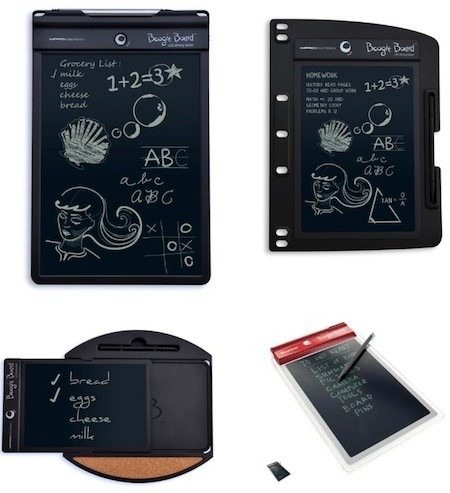
Remember the Boogie Board that Julie reviewed awhile back? Well it seems that Improv Electronics has updated their Boogie Board line. The new line includes a bigger Boogie Board of 10.5” which will cost $60, a $45 8.5” binder slate, and a Brookstone exclusive $40 slate.
The 10.5” version has added features such as, a built-in stylus holder, a lock button to prevent accidental erase, user replaceable batteries, and a place to loop your charms to give a more customized look to it.
There’s a new $20 accessory as well for the original Boogie Board where you can slide it into a cork board style holder.



Gadgeteer Comment Policy - Please read before commenting
Jackie, it’s wild that you should post this today! This morning I just thinking about digging out my Boogie Board to use to keep track of how much water I drink during the day. I thought about adding some magnets to the back so I can attach it to my fridge.
Did wish they make a version that allows image saving though. Hopefully in the future they will put that functionality in.
I agree… I wish there was a way to save screens. And I wish there was a way to have a color version 🙂 If we’re going to wish, let’s wish big!
LOL…any more wishing then it’ll end up being the next ipad and costing $800! hahaha
Hey guys! I saw this story and just wanted to let everyone know that we are launching a Boogie Board tablet with save functionality this fall. We aren’t releasing any specific details yet, but check out our new web site (www.improvelectronics.com), Facebook and Twitter pages in the coming months for more info.
@Kristen That’s fantastic news! I can’t wait to try it out 🙂
My Wife would love this but she would kill me if I paid 60.00 for it LOL
The ability to “save” would require a whole different technology. Currently, there is no individually addressable pixels of any kind in the Boogie Board’s design…it is just one big soup of crystals.
It is one of the reason why the “tablet” is so inexpensive. There is nothing “electronic” going on. The ability to “write” is just a side effect of pressure on a soup of liquid crystals.
@RainyDayInterns – Depends, simple recording so you can display it on say a computer may not require whole new technology.
One way would be using the mechanism of how they erase by sending a small charge through the crystals to re-align them. A possible even lower charge below the threshold to re-align combined with sensors could be used to record those states instead.
Another is the matrix and the polarization state of the crystals could be recorded with transmitted light through the cholesteric liquid crystals to record their pattern and thus state.
Or something more traditional like a sensor to monitor the use of the pen and record it’s movements.
Hi James,
Those are interesting thoughts and would be cool if they could be implemented inexpensively.
Using the “erase” mechanism is seems less promising as the sensors would have to be in a grid fashion exactly like pixels. To read out the states would require addressing chips, memory, etc…which then begs the question of why bother reinventing the LCD?
A sensor pen is a whole separate tech…like the Pulse (camera to do the recording).
However, in thinking about it…it would be cool if there is something like a writable e-paper. It can display, but will also let a user write on it. As some of the addressing electronics are already required, perhaps adding the sensor layer as per your suggestion would not be cost prohibitive.
Of course, we are just blue-skying here and have no real clue as to the feasibility of any of it 🙂 Still, you do bring up an interesting suggestion.
From Kent Displays we can tell you that it is using the same technology with some added functionality to record the image. The price will be higher than the current Boogie Boards but only a fraction of the cost of a tablet.
We look forward to understanding how it works and are hopeful that it will be available soon!!!
We should clarify our meaning when we used the phrase “different technology”…perhaps it would be more accurate to say “different technique applied to using the same bi-stable technology?”
Our understanding is there is currently not an addressable grid on top of the layer of liquid crystals. If there are individual cells of bi-stable materials, then sure… it is reasonable to assume that the on/off state of each cell can somehow be read and stored. But unless there is an addressable grid imposed over the tablet, it is unclear how an image can ever be recorded.
The low-power consumption feature of bi-stable material is very exciting and we look forward to see cool applications of the tech.